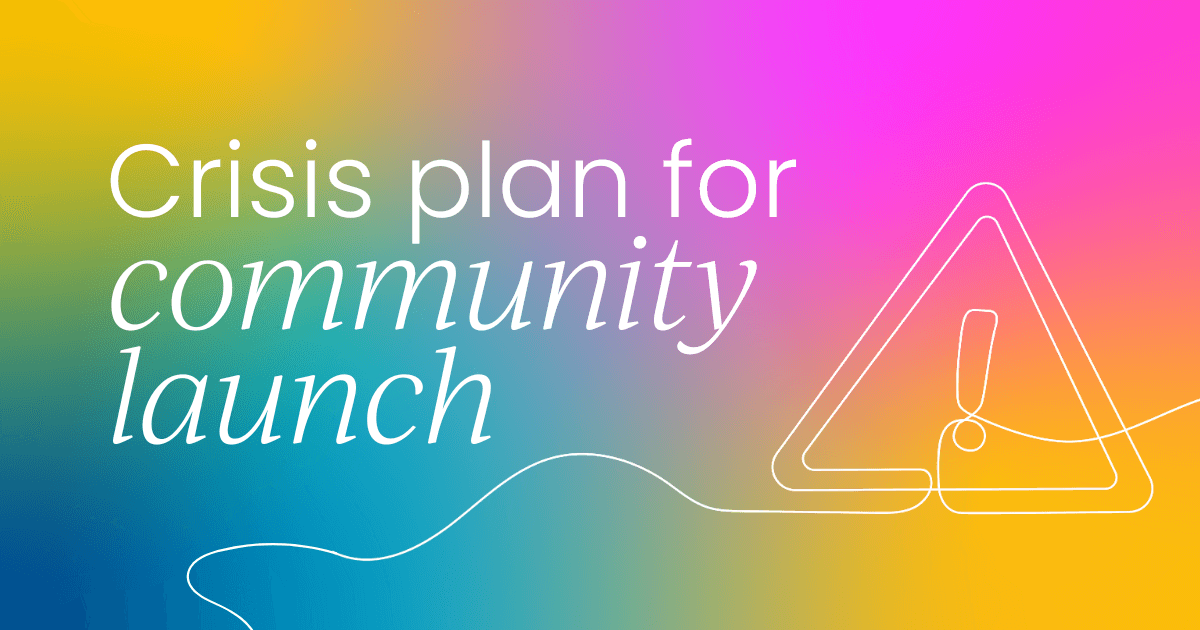Launching an online community is an exciting adventure.
It’s a powerful opportunity to scale engagement, foster brand loyalty, and create a feedback loop between your organization and its users.
But it’s easy to overlook one sobering reality: no matter how well you prepare, challenges will come up.
Technical hiccups, unexpected customer reactions, negative media attention, or internal communication failures can turn a promising initiative into a brand liability if not handled well.
That’s why having a strong, actionable crisis plan is the cornerstone of any community’s success.
Expect the unexpected and protect your brand
Even with months of planning, dry runs, and cross-functional alignment, your launch can still be sideswiped by unexpected events.
Having a crisis plan under your belt is both an insurance policy against potential brand damage, as well as a roadmap for recovery.
External shocks happen
Community managers rarely operate in a vacuum. Your launch could collide with external forces like:
- Global events (e.g., natural disasters, political disruptions, or pandemics),
- Industry news cycles (a competitor’s surprise announcement or negative press),
- Platform issues (downtime or API deprecations if you rely on third-party integrations).
For example, think about how many product or community launches had to pivot (or pause entirely) during the onset of COVID-19. In such moments, a crisis plan enables a "super reactive" and "agile" messaging strategy that communicates empathy, transparency, and adaptability.
It helps you pivot your tone, reframe expectations, and maintain relevance in a changed context.
Your reputation is on the line
When launches go sideways without a contingency plan, the consequences can be severe:
- Confusion and anger among early adopters,
- Viral backlash on social media,
- Press coverage that undermines future traction,
- Investor or executive scrutiny.
A well-structured crisis plan includes playbooks for rapid response, customer messaging templates, and decision-making escalation paths.
As seen in past tech industry mishaps (like poorly vetted AI rollouts or mishandled data breaches) companies without clear crisis protocols often face long-term brand damage.
On the other hand, organizations that own their mistakes and communicate proactively are often seen as more trustworthy.
Customer discontent escalates fast
Imagine a scenario where users face account lockouts due to a bug in your onboarding system.
Without a coordinated crisis response, complaints can pile up on social channels, trust evaporates, and your customer success teams are left scrambling.
By including customer journey risks in your crisis planning, you can:
- Preemptively set up alternate communication channels (like status pages or email alerts),
- Prepare refund or incentive policies,
- Identify high-value customers most likely to churn and trigger proactive outreach.
Encourage internal alignment and accountability
Don’t be fooled – an effective crisis response isn’t just about responding to customer and community members messages quickly. In fact, it hinges on your team’s ability to work in unison. Clarity around roles, workflows, and authority is essential when time is of the essence.
Clarity on who owns what
In the fog of a crisis, indecision can be more damaging than the issue itself. Without predefined decision rights, teams fall into the trap of a “mosh pit of decision making,” where responsibilities blur and progress stalls.
That’s where frameworks like RACI (Responsible, Accountable, Consulted, Informed) or RAPID come in. These frameworks force you to ask:
- Who leads customer communication?
- Who owns product or engineering triage?
- Who must approve legal language or compensation offers?
Answering these in advance allows you to respond in hours – not days – during a crisis.
Cross-functional collaboration is non-negotiable
A community launch typically touches nearly every function: Product, Engineering, Legal, PR, Customer Support, Sales Enablement, and more.
If these teams aren’t aligned during a crisis, you risk giving customers mixed signals or conflicting information.
Build cross-functional rituals before the launch:
- Include all stakeholders in dry runs and simulations,
- Establish shared Slack channels or crisis war rooms,
- Run “tabletop” exercises to test hypothetical crisis scenarios.
These investments ensure everyone is on the same page when the pressure is on.
Stay grounded in the community’s mission
Your community launch should tie into a broader business goal: increasing customer retention, accelerating product adoption, or strengthening advocacy. A crisis plan helps you protect and reaffirm that purpose – even amid disruption.
When your messaging, decisions, and remediation efforts reflect your community’s north star, it becomes easier to:
- Rally internal teams around the same goals,
- Make trade-offs with confidence,
- Reinforce the community’s long-term value to executives and board stakeholders.
How to build a resilient framework for continuous engagement
A crisis plan is more than a fire extinguisher; it’s a blueprint for resilient, adaptive growth. It sets the tone for how you engage customers long after the initial launch buzz fades.
Move from reactive to proactive
Great crisis management isn’t just about reacting quickly. It’s about foreseeing where issues may emerge and taking preemptive action. This includes:
- Auditing the community onboarding experience for friction points,
- Monitoring early user activity to flag anomalies,
- Building early-warning systems using NPS scores, support ticket patterns, or sentiment analysis.
A culture of proactive problem-solving helps you avoid “random fire drills” and focus on continuous improvement.
Communicate strategically – both internally and externally
Crisis comms must be multi-channel, precise, and human. You’ll need to consider:
- Who your primary audiences are (e.g., power users, moderators, investors),
- Which platforms to use (email, social, in-app messaging, etc.),
- How often to provide updates (daily, hourly, post-resolution).
Internally, feedback loops between community teams and stakeholders help reinforce trust and accountability. Share updates even when there’s nothing new to report. Silence can breed anxiety.
Let data be your compass
Quantifying the impact of your crisis response helps you iterate faster. Use KPIs like:
- Response time to community issues,
- Volume and resolution rate of support tickets,
- Sentiment trends across channels,
- Post-crisis customer satisfaction or retention shifts.
When you step back and measure what matters, you empower your team to refine the playbook and prevent repeat incidents.
Build relationships that withstand storms
At the heart of any community are people. The more transparent and authentic you are during challenges, the more resilient those relationships become.
Being upfront about data use policies, acknowledging mistakes, or explaining delays – even if imperfect – builds goodwill. Communities forgive errors more than they forgive silence or spin. That authenticity will be remembered when your next campaign or launch rolls out.
Launch your community with confidence
Launching an online community is more than hitting “publish” on a new platform. It’s about nurturing a living, breathing ecosystem of trust and value. And that trust is forged in moments of tension, not just celebration.
By developing a comprehensive crisis plan, one that spans communication, governance, data analysis, and shared purpose, you set your community up for more than survival. You set it up for scale, loyalty, and long-term advocacy.
Don’t wait for the unexpected to happen. Plan for it, rehearse for it, and most importantly, build a culture that sees every challenge as a moment to prove your commitment to your customers.
Your launch may last a week. But how you handle a crisis? That’s what people will remember.


 5 min read
5 min read
 Follow us on LinkedIn
Follow us on LinkedIn



